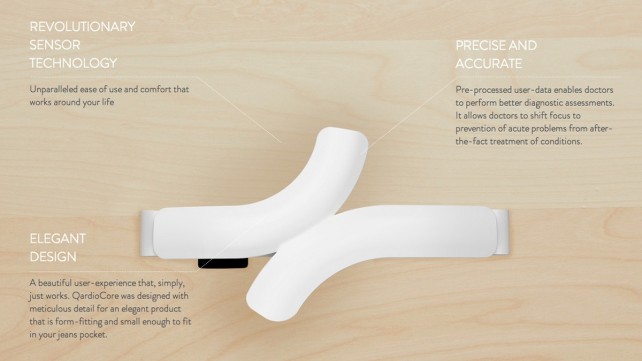The co founder of Qardio Marco Peluso had a career in the finance industry for 14 years. He worked as an investment banker for JPMorgan and then as a partner at a hedge fund.
But things changed when his father had a stroke while they were talking on the phone. “I was lucky enough to understand what was happening,” he said, remembering that he quickly contacted a neighbour to take his father to the hospital. But doctors could not identify what triggered the minor stroke, known as a Transient Ischemic Attack or TIA. Only six months later, his father found himself struggling to finish his morning jog. “It was shocking for me to know that even now, we didn’t have a good way of understanding or proving what was happening,” Peluso said.

He was compelled to leave his career to start Qardio, which is set to launch the Blood pressure monitor product for consumers next year at a price of $449. They also have a another product, a blood pressure monitor called QardioArm that will retail for $99.
The ECG monitoring device, called the QardioCore, will stream data to the owner’s iPhone and can then send the data on to a person’s health care provider through a cloud-based service. In effect it lets a doctor “see” a patient without really seeing them in person.

Peluso says his QardioCore product is less effort-intensive than other sophisticated monitors, which might require skin patches or shaving a person’s chest etc or maybe using adhesive gel. “It doesn’t require any skin preparation,” he said. “You put it on your chest, it switches itself on when it detects your body, then wirelessly sends signals to your iPhone, which then go to our server.” He says the two devices correct a major problem in health monitoring because they make ECG and blood pressure data tracking passive. This means that doctors can collect a stream of data and put it in context instead of taking singular, one-off measurements.
Peluso and his co-founder employed a team of engineers and industrial designers to work on designing both the QardioArm and QardioCore over the past year. The manufacturing process is in Southeast Asia and the company plans to retail both devices online and through established physical partnerships early in 2014.
But things changed when his father had a stroke while they were talking on the phone. “I was lucky enough to understand what was happening,” he said, remembering that he quickly contacted a neighbour to take his father to the hospital. But doctors could not identify what triggered the minor stroke, known as a Transient Ischemic Attack or TIA. Only six months later, his father found himself struggling to finish his morning jog. “It was shocking for me to know that even now, we didn’t have a good way of understanding or proving what was happening,” Peluso said.

He was compelled to leave his career to start Qardio, which is set to launch the Blood pressure monitor product for consumers next year at a price of $449. They also have a another product, a blood pressure monitor called QardioArm that will retail for $99.
The ECG monitoring device, called the QardioCore, will stream data to the owner’s iPhone and can then send the data on to a person’s health care provider through a cloud-based service. In effect it lets a doctor “see” a patient without really seeing them in person.

Peluso says his QardioCore product is less effort-intensive than other sophisticated monitors, which might require skin patches or shaving a person’s chest etc or maybe using adhesive gel. “It doesn’t require any skin preparation,” he said. “You put it on your chest, it switches itself on when it detects your body, then wirelessly sends signals to your iPhone, which then go to our server.” He says the two devices correct a major problem in health monitoring because they make ECG and blood pressure data tracking passive. This means that doctors can collect a stream of data and put it in context instead of taking singular, one-off measurements.
Peluso and his co-founder employed a team of engineers and industrial designers to work on designing both the QardioArm and QardioCore over the past year. The manufacturing process is in Southeast Asia and the company plans to retail both devices online and through established physical partnerships early in 2014.

0 comments:
Post a Comment